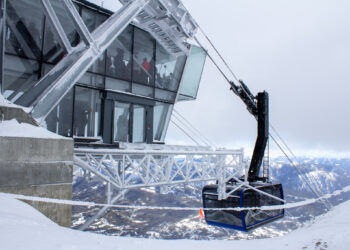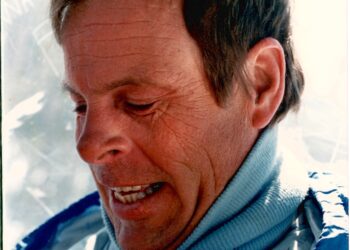EBS STAFF
BIG SKY – In a town where the big sky above feels like the limit, it’s only natural for developments of all shapes, sizes and purposes to spring up in virtually every corner of this unincorporated community’s census-designated boundaries. Intended to help meet the needs of growing residency and visitation numbers, such operations are reliant on infantry, the commercial trucks that haul in everything from raw building materials to appliances.
But in a community that has been shaped from scratch by individuals and organizations alike, there is a disconnect between the peaceful mountain setting many hope to achieve and the steady stream of trucks that cut through the heart of the town every day.
According to data collected by the Bozeman office of Sanderson Stewart, a civil engineering company, 450 heavy trucks head westbound on Lone Mountain Trail each day. All of these trucks also return eastbound toward Highway 191, bringing the Lone Mountain Trail truck traffic tally to a total of 900 individual passes daily.
The data, collected in August 2019, also found 260 of those 450—nearly 60 percent of all heavy trucks entering Big Sky—turn left off Lone Mountain Trail onto Ousel Falls Road. Considering that each of those trucks then returns to Lone Mountain Trail via Ousel Falls Road, this means there are 520 individual heavy truck passes each day on Big Sky Town Center’s chief transportation artery.
Sanderson Stewart-collected data also revealed that only eight medium or heavy trucks crashed on Lone Mountain Trail between July 1, 2006, and June 20, 2016, out of a total of 182 crashes that involved no pedestrians; both of those figures are below the statewide crash averages for similarly classified roadways in both urban and rural settings. Still, Joey Staszcuk, a project engineer for Sanderson Stewart, spoke anecdotally of unease he experienced at the corner of Lone Mountain Trail and Ousel Falls Road.
“While the whole safety aspect is a really hard thing to pin down, we had the signals built at that intersection, and there are just so many trucks cruising by,” Staszcuk said. “I certainly would not want to be working construction at that intersection because of speed and volume of truck traffic.”
According to information from a Town Center Owners Association newsletter, “Big Sky Town Center’s ‘walking village’ design makes the neighborhood a unique place to live and work with proximity to dining, shopping, entertainment, trails, parks, essential services and nature. Pedestrian-friendly communities offer a better quality of life, higher, more stable property values, and more opportunities to get to know others in the community.”
Despite the lack of accidents involving pedestrians, a truck’s ability to react and stop quickly the way a passenger vehicle might, is hindered, Staszcuk wrote in an email to EBS. He added that safety concerns are compounded by the facts that clear visibility of surroundings is diminished in such vehicles and slower times to gain speed from a point of standstill have a natural impact on the flow of traffic.
However, through several public-private partnerships spearheaded by organizations like Big Sky Town Center and the Big Sky Community Organization, many safety measures such as crossing flags, flashing beacons and signage denoting maximum speeds have contributed to a safer Big Sky Town Center experience for pedestrians.
Still, the inability of a commercial truck to quickly gain speed after coming to a stop will inadvertently contribute Big Sky’s traffic woes, as the projected annual growth rate for Lone Mountain Trail’s traffic volume—set forth by the Sanderson Stewart 2017 traffic study that was used in the application for the more-than $10 million awarded to Big Sky via a federal TIGER grant—is 4.34 percent. And Staszcuk says the AGR is actually more like 10 percent, according to recent analysis.
A study isolating current traffic conditions on Ousel Falls Road is underway: In order to arrive at better-informed policy and possible changes to the way heavy trucks, along with all traffic, interact with Big Sky Town Center and Ousel Falls Road, the Town Center Owners Association, Big Sky Community Organization, Spanish Peaks Mountain Club and Yellowstone Club wrote letters of support for a traffic study to be conducted by Bozeman-based engineering firm Morrison-Maierle, the manager of a Rural Improvement District (RID) that maintains Ousel Falls Road on behalf of Gallatin County.
This June, Morrison-Maierle submitted those letters to the county commissioners of Madison and Gallatin Counties, and is awaiting tentative approval to use RID dollars to conduct the study.
Less obvious, though, are the dangers to one’s ears.
According to Odyne Systems, a Wisconsin-based manufacturer of hybrid utility trucks, the average diesel engine found in heavy commercial trucks produces approximately 100 decibels of noise, which is 10 decibels less than a chainsaw and 7 decibels less than a power mower, according to a chart from a Yale University Environmental Health Services study.
Even before the noises of trucks are amplified by the flat, canyon-like walls of the buildings adjacent to Ousel Falls Road at the intersection of Town Center Avenue, just 15 minutes of prolonged daily exposure to 100 decibels can cause damage to the ear resulting in potentially permanent hearing loss, reports the American Speech-Language-Hearing Association—and every increase in 3 decibels cuts that safety window’s duration in half.
The effects of the noise have not gone unnoticed by several members of the business community that are situated along the route.
“We have two beautiful entries to our business,” said Courtney Collins, gallery director for Creighton Block Gallery. “I just wish we could have the doors open to be inviting, for people to walk in and get that foot traffic. But it’s just so loud.”
Bianca Godoy, daughter of Brenda and Alberto Godoy, co-owners of Alberto’s Mexican Cuisine on Ousel Falls Road, serves and bartends at her family’s establishment. She says noise complaints from their customers are not uncommon.
“We get complaints more or less every other day during lunchtimes in the summer. People complain about the noise, it just disrupts everything—servers can’t hear and everyone has to speak louder—as it’s otherwise really quiet outside,” Godoy said. “They always ask if there’s another road that the trucks can take.”
Frank Kern, the newest owner of Big Sky food service mainstay The Hungry Moose Market and Deli, has fielded similar complaints, but acknowledged that there are two sides to the coin.
“You’ll get two types of comments, comments about the noise of the trucks, and comments about the noise of progress,” Kern said.
As the saying goes, “a rising tide lifts all boats,” and both privatized and public developments bolster the community’s housing, recreation and public amenities, attracting people of all walks to add their DNA and varying backgrounds to the fabric of the growing community.
Additionally, a service or auxiliary route, as mentioned by Godoy, isn’t necessarily feasible, Staszcuk says.
“The cost of building a temporary road is just not worth it, especially in a place like Big Sky with the short window for things to be constructed,” he explained. “And that’s not even considering impacts to things like interfering with hospital operations, where that access needs to be wide open.”
Certainly, there was a time in every more-established town and city around the nation when construction dominated the landscape—to the benefit of future generations who fortuitously avoided the bustle associated with major growth. The notion harkens back to a series EBS ran this spring titled “Growing Pains,” and perhaps recommends an acceptance that not everything will be perfect in a town on the rise; no pun intended, it’s all part of the ride.















